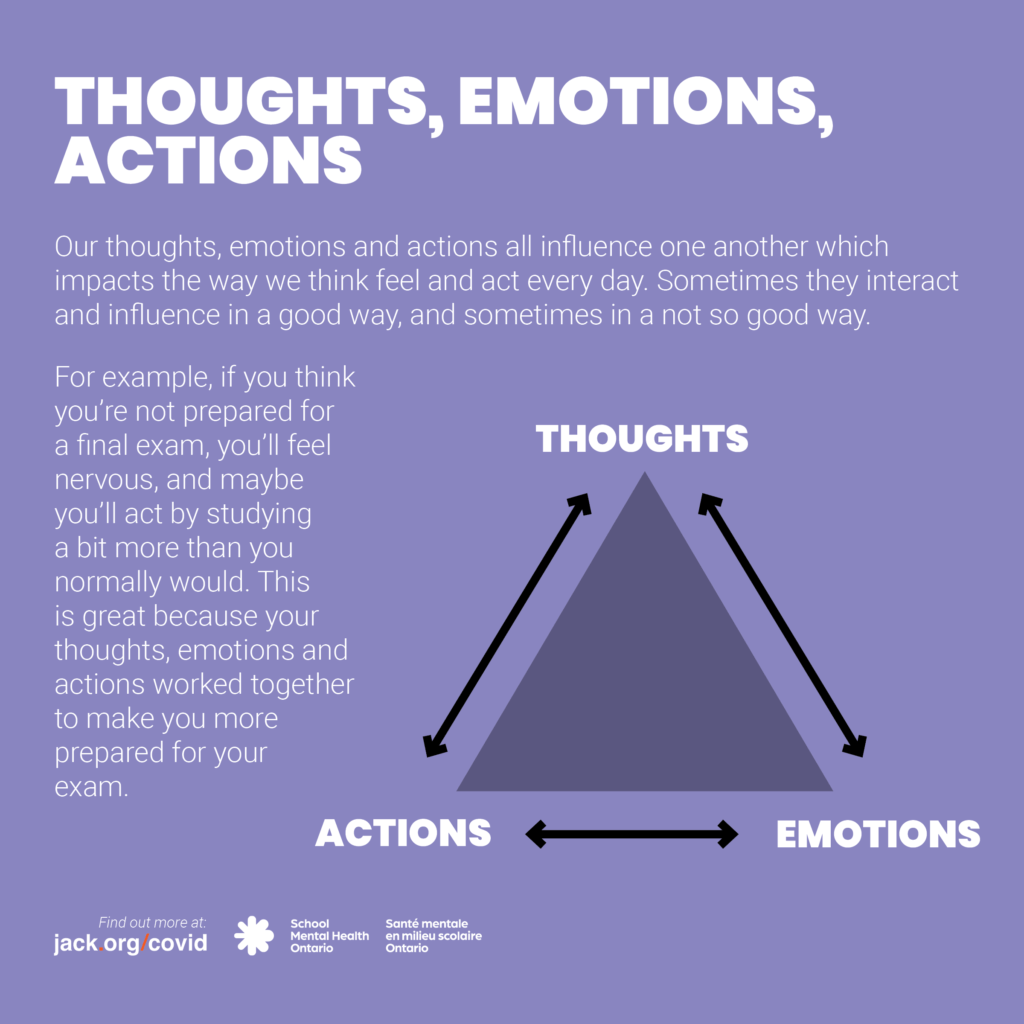


Time
5-10 minutes
Frequency
Monthly
Material
N/A
Purpose
To reinforce that thoughts, emotions and actions are interrelated and that breaking the negative thinking cycle can help students feel happier and healthier
The idea of thoughts and actions influencing our emotions is true for marginalized and racialized students as well. However, there may be negative assumptions/biases about the Black community and other marginalized communities that may inform and invade a student’s thoughts about themselves. This must be challenged and explicitly addressed to overcome the development of a negative sense of self.
Furthermore, it is important to recognize when students are marginalized, they may experience micro-aggressions; therefore, it is important to validate their experience, rather than saying that they should change their thoughts about the situation.
Please make sure to review the “Considerations” section before starting this practice.
- Provide context, where students sometimes start to show unhealthy habits of thought. Unrealistic thinking can lead to negative emotions like sadness and anger. When these thoughts are not managed early, they are increasingly hard to change. Helping students engage in more realistic thinking, and attributions for others’ behaviour can help teach them to manage their emotions.
NOTE: It is important to distinguish between negative thinking and negative experience. Marginalized youth may experience systemic/oppressive situations that can affect them. Students need validation and support in these situations.
- Provide an example to illustrate how easy it is to misinterpret the emotions and behaviours of others.
- Emphasize that when we make negative assumptions, it can make us think negative thoughts, and feel negative emotions.
- Use a TEA Triangle (Thoughts/Emotions/Actions) to highlight common negative thoughts and how these can lead to negative feelings and actions.
- Give students a chance to work in pairs or small groups to complete the worksheet.
- Provide prompts to students.

Thoughts, Emotions, Actions
The image contains a triangle diagram. “Thoughts”, “emotions”, and “actions” are each written at one corner of the triangle. Double ended arrows run along the sides of the triangle, connecting the words at each corner.
The text on the image reads:
Our thoughts influence our emotions, our emotions influence our actions and our actions influence our thoughts. Sometimes, our thoughts influence our emotions and actions in a good way.
For example, if you think you’re not prepared for a final exam, you’ll feel nervous, and maybe you’ll act by studying a bit more than you normally would. This is great because your thoughts, emotions and actions worked together to make you more prepared for your exam.
Thoughts and emotions are bi-directionally influential, which means that emotions influence one’s thoughts about a situation, and their thoughts influence their emotional reaction to a situation (Clore & Palmer, 2009; Oatley & Johnson-Laird, 2014). Understanding this phenomenon is the first step in developing the skills to manage this cycle, by changing the way students think about situations (Webb et al., 2012). Having a graphic organizer or node map that outlines strategies to try, which help students self-monitor their understanding about the source of their emotions can influence their behaviour/reactions, and lead to improvements in social competencies (Embry & Biglan, 2008).
Clore, G. L., & Palmer, J. (2009). Affective guidance of intelligent agents: How emotion controls cognition. Cognitive Systems Research, 10(1), 21-30. doi:10.1016/j.cogsys.2008.03.002
Embry, D. D., & Biglan, A. (2008). Evidence-based kernels: fundamental units of behavioral influence. Clinical child and family psychology review, 11(3), 75–113. doi:10.1007/s10567-008-0036-x
Oatley, K., & Johnson-Laird, P. N. (2014). Cognitive approaches to emotions. Trends in Cognitive Sciences. doi:10.1016/j.tics.2013.12.004
Webb, T. L., Miles, E., & Sheeran, P. (2012). Dealing with feeling: A meta-analysis of the effectiveness of strategies derived from the process model of emotion regulation. Psychological Bulletin, 138(4), 775- 808. doi:http://dx.doi.org/10.1037/a0027600
Or, view all practices and use filters to find what you need
